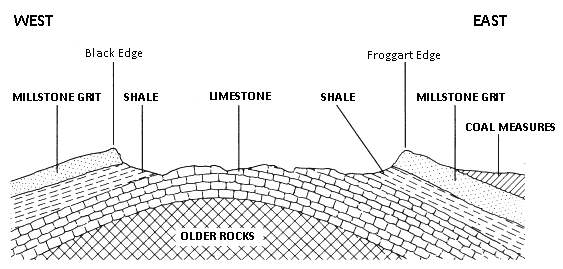Geology
The peak district is made up of many layers. It all began as an ancient sea hundreds of millions of years ago. Living creatures in these seas died and fell to the seabed, forming a layer of Limestone. Over time, the seas changed to rivers when a mountain range formed in the North. These rivers deposited mud, forming a layer of Shale.

As the river aged, and the mouth and delta grew bigger, sand was deposited forming a layer of Sandstone known as Millstone Grit. Finally, as sea levels fell in the Carboniferous period, the area was taken over by plants and trees. When these died, the formed a layer of Coal Measures.
These deposits once covered the whole of the Peak District. After the Carboniferous period, movements deep within the Earth pushed the centre of the Peak District up to form a big dome shape.

Erosion of the raised dome caused the Coal Measures and Sandstone at higher altitudes to disappear. This was caused by, amongst other methods, particles of rock and dust that was previously trapped within glaciers in the Ice Age being carried by the wind once the glacier melted. This particle heavy wind battered the exposed Millstone Grit, wearing it away over time, and exposing the shale and limestone beneath, which now forms the surface of the centre of the Peak District (for example, The Hope Valley). The remains of the coal measures are only to be found at the eastern extremes of the formation.
The Ox Stones
The Ox Stones are a remnant of the deposit of Millstone Grit. The remains of the Millstone Grit layer are most visible in places such as Froggatt Edge near Grindleford, but some small patches survived the erosion, and are commonly found on high ground. These were known as 'tors', and the Ox Stones are an example of this.
Other examples can be found further into the Peak District, such as the Salt Cellar, the Cakes of Bread, and the Coach and Horses. Many of these have been named locally in the past and the name stuck. It is likely that the ox stones were named because from a distance they resembled oxen.
Logging Your Find
In order to log your find, please send a message to my profile answering the following questions. In addition, optionally upload a picture of yourself and the stones showing their scale. You can log your find immediately, but please send the answers within 24 hours. You may need to do some research to answer these questions!
- In some detail, describe how the stones look and feel.
- Why do you think the rock is made up of a number of thin layers?
- Some of the layers are not horizontal. Can you explain why?
- The circumference of the rock is smaller at the base (the stone gets wider the higher it is). Can you explain why?
Once I have received your message I will respond as soon as I can. Logs where incorrect or incomplete answers have been given, or where an email has not been received, may be deleted.
I hope you enjoy the cache! As always, any feedback is greatly appreciated!